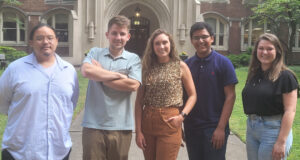CSB Spotlight: Wan Lab
 Some might say that Will Wan, assistant professor of biochemistry, is “one of our own.” Will completed his PhD at Vanderbilt University in the CSB lab of Gerald Stubbs, professor of biological sciences, emeritus. Will began his scientific studies at Binghamton University earning a bachelors degree in biochemistry and completed two postdoctoral fellowships in Germany. He eventually decided to bring his cryo-ET talents back to Vanderbilt and the CSB.
Some might say that Will Wan, assistant professor of biochemistry, is “one of our own.” Will completed his PhD at Vanderbilt University in the CSB lab of Gerald Stubbs, professor of biological sciences, emeritus. Will began his scientific studies at Binghamton University earning a bachelors degree in biochemistry and completed two postdoctoral fellowships in Germany. He eventually decided to bring his cryo-ET talents back to Vanderbilt and the CSB.
What projects does your lab currently work on? We are interested in studying the molecular mechanisms of viral life cycles. This includes understanding how viruses bind and enter host cells, how they replicate within cells, and how they assemble and bud new virions. Our particular interest is in the single-stranded negative-sense RNA viruses, which include a number of important human pathogens including mumps, rabies and respiratory syncytial virus. We are currently working on studying Ebola and measles viruses.
What are the primary tools and techniques you use to answer these questions? Our primary approach to studying these viral processes is to use in situ structural biology, which aims to study molecules “in place” within their native environments. When studying viruses by themselves, this means studying them intact, rather than purifying their constituent components. For studying virus-host cell interactions, this involves visualizing the viral molecules within infected cells. In both cases, our main method is cryo-electron tomography (cryo-ET), a special subset of cryo-electron microscopy (cryo-EM) that allows for molecular-resolution imaging in complex environments. Cryo-ET data can be computationally processed in a number of ways to yield a range of different data including high-resolution structures, molecular conformations and interactions, and the spatial arrangements of molecules within cells. While cryo-ET is a powerful method, no single approach can yield a complete picture of biological processes, so we also use a number of different approaches such as biochemistry, molecular biophysics, molecular biology, cell biology and computation.
What was your path to this position? What is your favorite part of being a PI? I first performed undergraduate research while doing my bachelors in biochemistry at Binghamton University, where I studied proteolytic enzymes in plants. I started in structural biology during my PhD here at Vanderbilt in the lab of Gerald Stubbs. My dissertation focused on studying the biophysics of prion folding using X-ray fiber diffraction. After finishing my PhD, I did two postdocs abroad in Germany. The first was with John Briggs, then at the European Molecular Biology Laboratory, studying the structure of Ebola and Marburg viruses using cryo-ET. I then moved to the lab of Wolfgang Baumeister at the Max Planck Institute of Biochemistry, where I learned to do cellular cryo-ET. Over time, my focus there became completely computational, where I began working on algorithms for processing cellular cryo-ET data. In starting my lab, my goal was to take elements from each of my previous experiences to develop a research program that aims to gain a deeper and more holistic understanding of how viruses work. So far, my favorite part about being a PI has been in building and training a talented team that is excited to make new discoveries.
What are some fun lab activities you like to do? With starting the lab during a pandemic, we haven’t been able to develop as much of a lab culture as I would have liked, though it turns out we’re pretty good at trivia. I expect that cake will also play an important role in our lab.
What do you think is the key to running a successful group? I think the key to running a successful group is to build a collaborative team. Everybody has their own strengths and weaknesses and working as a team not only improves the group’s output as a whole, but is essential to the development of each individual.
Leave a Response
You must be logged in to post a comment